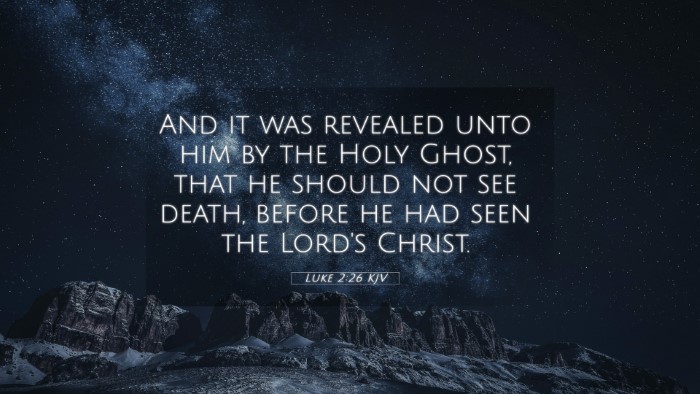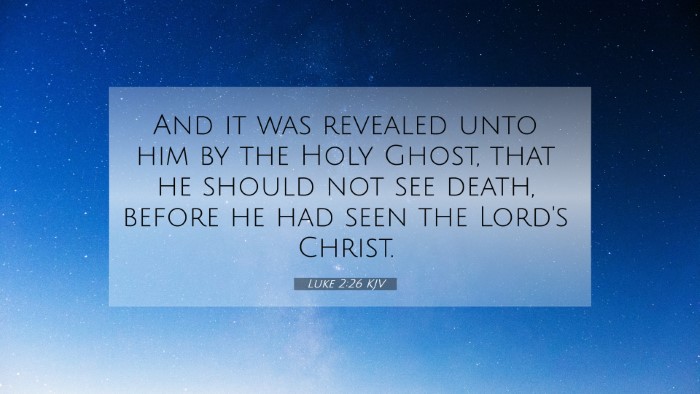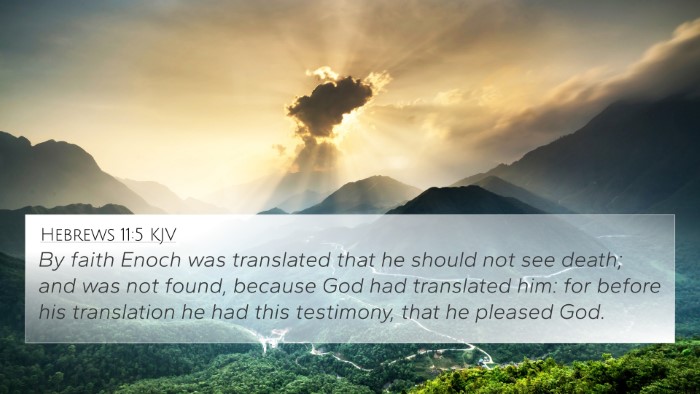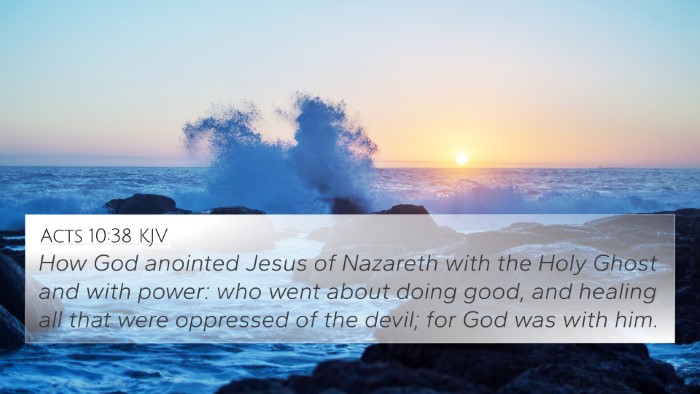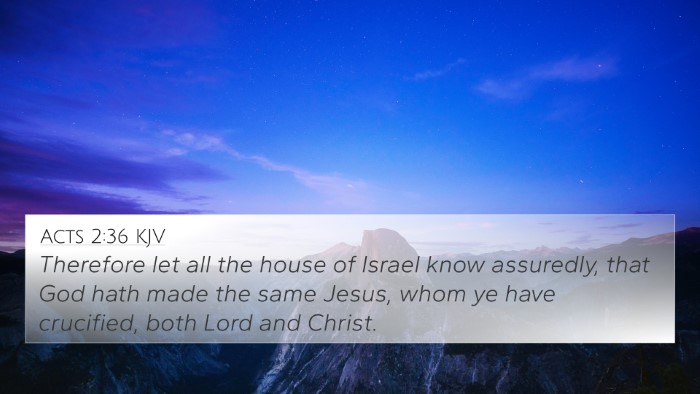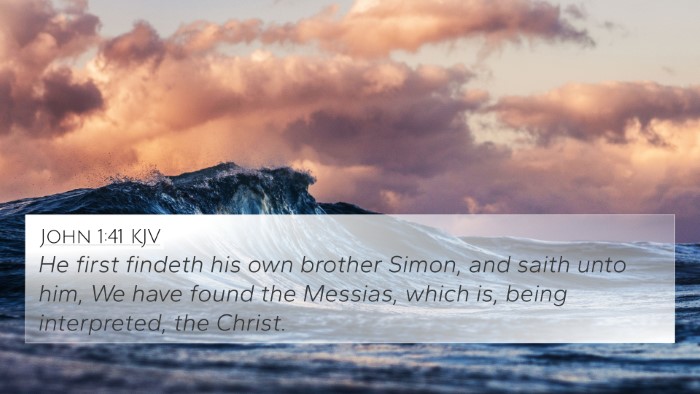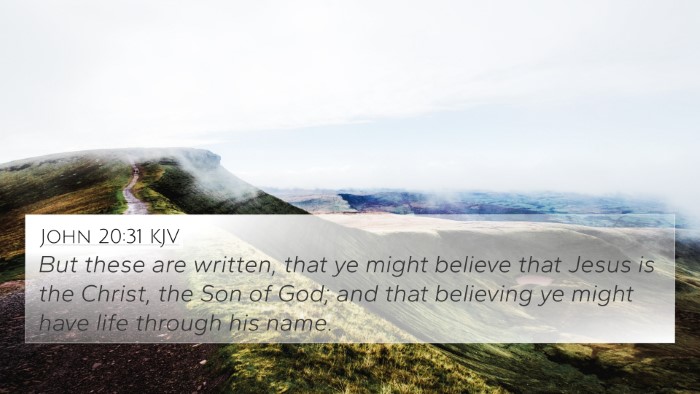Bible Verse Meaning: Luke 2:26
Bible Verse: Luke 2:26 - "And it was revealed unto him by the Holy Ghost, that he should not see death, before he had seen the Lord's Christ."
Summary of Interpretation
The verse Luke 2:26 highlights the profound moment in the life of Simeon, a righteous man in the temple, who was given a divine promise by the Holy Spirit. This revelation was significant—not only did it assure Simeon he would see the Messiah before his death, but it also illustrates the theme of divine assurance and fulfillment of God’s promises, as explored in various Biblical texts.
Thematic Connections
- Divine Revelation: Simeon’s insight into the future was provided by the Holy Spirit, suggesting a pattern of God communicating His plans to His faithful servants. This mirrors instances such as Luke 1:67-79, where Zechariah is filled with the Holy Spirit and prophesies.
- Messianic Expectation: Simeon’s anticipation of seeing the Lord's Christ underlines a key theme in the Gospels; the hope for the Messiah’s coming. This is echoed in Isaiah 40:3, which prepares the way for the Lord.
- Faith and Righteousness: The character of Simeon represents the faithful waiting for God’s promise, resonating with Hebrews 11:1, which defines faith as the assurance of things hoped for.
- Fulfillment of Prophecy: Simeon's encounter with the infant Jesus signifies the realization of Old Testament prophecies, connecting to texts like Micah 5:2, which foretold the birthplace of the Messiah.
Cross-References
Luke 2:26 links to several other scripture passages that illuminate its meaning:
- Isaiah 9:6 - The prophecy affirming Jesus as the Messiah.
- Luke 1:26-35 - The Annunciation to Mary regarding the birth of Jesus, emphasizing divine intervention.
- John 1:29 - John the Baptist identifying Jesus as "the Lamb of God."
- Matthew 2:11 - The visit of the Magi and their recognition of Jesus as the King.
- Acts 2:33 - Peter referring to the Holy Spirit's outpouring as fulfillment of God’s promise.
- Romans 8:15-16 - The intimate relationship believers have with the Holy Spirit, who reassures us of our identity in Christ.
- Galatians 4:4-5 - The fullness of time when God sent His Son to redeem those under the law.
Analysis of the Verse
In examining this verse, we note Simeon’s character as just and devout—a model of faithfulness. His connection to the Holy Spirit is significant, as it emphasizes that understanding God’s will often comes through spiritual discernment. Matthew Henry comments on how such revelations are part of God’s ongoing engagement with humanity, particularly through the Holy Spirit's guidance. Albert Barnes emphasizes the importance of Simeon’s anticipation, as it reflects a broader expectation of the Messiah during that period in Israel's history. Adam Clarke's commentary brings to light the concept of divine timing, reminding readers that God's promises unfold in His perfect timing, a theme present throughout scripture.
Exploring the Holy Spirit's Role
The mention of the Holy Spirit in Luke 2:26 is paramount. It recalls the continuous theme throughout the Bible of the Spirit guiding and revealing God’s intentions. In Acts 1:4-5, we see the importance of waiting for the Holy Spirit, echoing the necessity of a spiritual readiness to receive God’s revelations.
Faith as a Theme
Simeon’s faith was not passive; rather, it was active—a waiting on the Lord, akin to Psalm 37:7, which encourages believers to be still and wait patiently for Him. His assurance before death serves as a testament to the promises God holds for those who faithfully seek Him.
The Broader Context of Luke 2
This verse is situated within a larger narrative of the birth and early life of Jesus, a theme reflecting fulfillment and expectation that permeates the Gospel of Luke. The connections between the various accounts of Christ’s early life and the prophetic messages leading to this moment reveal a tapestry of divine orchestration.
Conclusion
Luke 2:26 stands as a profound reminder of the faithfulness of God to His promises. Through Simeon’s experience, we are invited to reflect on our own faith and expectation as we await the fullness of God's plans in our lives. The cross-references provided not only enrich the understanding of this single verse but also reveal a larger biblical narrative that encourages believers to engage in thematic Bible verse connections, forging links between the Old and New Testament insights on the nature of God's promises.

